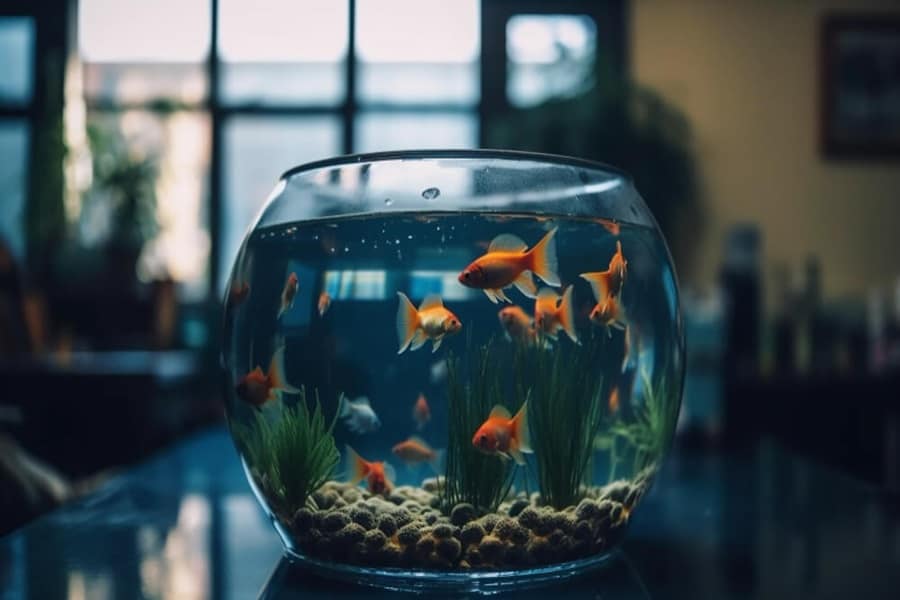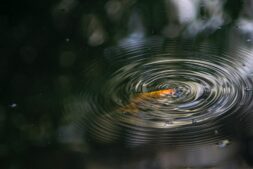Owning a beautiful aquarium teeming with vibrant fish can be rewarding when you have learnt how to clean a fish tank and filter the right way. In this article, you will learn the process of how to clean a fish tank and filter, ensuring a healthy aquatic environment for your fish. We will also highlight the importance of prepping the tank to safely remove your fish, cleaning the sides, gravel, plants, rocks, decorations, cleaning different kinds of fish filters, and much more.
Table of Contents
What you will need:
- A bucket of tank water to use during the water change.
- A clean cloth.
- Switch off the electrics to the tank.
- Remove the tank lid.
Prepping Your Fish Tank for Cleaning
Although you think you may know how to clean a fish tank, cleaning it the right way can produce different results, especially in terms of the well-being of your fish. Remember, maintaining a stable environment is key to fish health, and you should not remove all the water from the tank as this can disrupt the bacteria and nitrogen cycle that support your fish’s health.
- Turn Off Electrics and Remove the Lid: Begin by switching off all electrical equipment connected to your tank, including heaters and filters. Safely remove the tank’s lid.
- Keep Your Fish In the Tank: Keep your fish in the tank during cleaning. Removing them can cause unnecessary stress and potential harm. Fortunately, you don’t need to drain the tank entirely to clean it effectively.
- Partial Water Change: Instead of replacing all the water, only change some of the water. This approach preserves the beneficial bacteria that inhabit your tank and maintains a stable nitrogen cycle, which is important for your fish’s health.
- Leave Plants and Decorations in Place: There’s no need to remove plants, rocks, or decorations unless they’re visibly dirty. These elements can remain in the tank while you clean the tank.
How to Clean Your Fish Tank:
Now that you have made the necessary precautions and preparation on how to clean a fish tank, now comes the fun part: cleaning it!
- Start with the Sides: Begin cleaning by unplugging the heater and filter. Gently scrape off algae from the sides of the tank using an appropriate scraper. If your tank is made of acrylic, use a plastic scraper instead of metal to avoid scratching the surface.
- Clean the Gravel: After cleaning the tank’s sides, focus on cleaning the gravel. Use a syphon to vacuum away debris and any gunk from the substrate. The syphon also allows you to remove a portion of the tank’s dirty water. Be aware not to remove more than 50% of the water, as this preserves the essential bacteria needed for your fish.
- Refill with Conditioned Water: Once the cleaning is complete, refill the tank with fresh water that has been treated with a dechlorinating conditioner. Make sure that the new water is fish-friendly before adding it to the tank. This should be the only time you introduce water to the fish tank during cleaning.
- Clean Plants, Rocks, and Decorations: Occasionally, when plants, rocks, or decorations gather visible dirt, it’s essential to clean them. Remove these items from the tank and gently scrub them under running water. Ensure that no soap or detergents are used, as they can harm your fish.
Things to Watch Out For

As you learn how to clean a fish tank, you may think that regularly cleaning the tank will make them happy. This can be affected by various factors, including the size of your fish tank, the number and types of fish you have, and the effectiveness of your filtration system. Here are some additional factors to consider:
- Size and Population: Larger aquariums with more fish tend to accumulate waste at a slower rate than smaller tanks with a higher fish density. Consider your tank’s size and the number of inhabitants when establishing a cleaning schedule.
- Behaviour habits: Observe your fish regularly to ensure they are behaving normally. If you notice any unusual behaviour, such as fish gasping for air or sluggish movements, it may be an indication that your tank needs attention. In such cases, consider performing a partial water change.
- Weekly Maintenance: For average-sized or larger fish tanks, implementing weekly partial water changes can significantly contribute to maintaining water quality and fish health. The cleaning process should follow the steps outlined in the previous section.
- Monitor Water Parameters: Keep an eye out for your water pH levels, nitrate, and ammonia levels. Maintaining these measurements over time can help you detect any irregularities. If you notice any problems here, this may lead to health issues for your fish or cloudy water in your tank.
- Cloudy Water: Cloudy water in your fish tank is a clear indicator of water quality issues and should not be ignored.
- Water Evaporation: Regularly monitor water levels in your tank in case of natural evaporation.
- Equipment Inspection: Regularly inspect all the equipment in your fish tank, including filters, pumps, and lights. Clean or replace the filter if needed.
Cleaning Your Fish Filter
A well-maintained fish filter is key for the performance of your fish tank, responsible for keeping the water clean and healthy for your fish. Here’s a step-by-step guide on how to clean a fish tank filter:
- Remove Filter Sponges: Start by disconnecting the filter and removing the filter sponges. Place them in a bucket of aquarium water or collected rainwater (if not too cold) to preserve the bacteria.
- Cleaning Sponges: Cleaning the sponges typically involves squeezing them underwater to remove trapped dirt and debris. In case they become clogged, rinse these thoroughly.
- Mechanical Filter Media: For mechanical filter media such as filter wool or pre-filter cartridges, rinse them under tap water. Clean thoroughly.
- Chemical Media: If you use chemical media such as an Activated Carbon or Phosphate Remover, rinse them if they are particularly dirty. If the media has deteriorated over time, either replace or remove completely.
- Replenish the Bacteria: After cleaning the filter, consider adding a Filter Starter product to reintroduce beneficial bacteria essential for biological filtration.
Do you own your own pool? Introduce these pool and deck ideas to your garden to transform it into a modern oasis.
Cleaning Tips for Different Filter Types:
Of course, with different fish tanks, you are also bound to get different fish filters too. Here is some advice on how to clean different fish tank filters:
- Canister Filter: Unplug and remove any attached equipment such as inline heaters. Fill a bucket with tank water and empty the filter media into it. Clean the canister, impeller, hoses, and small parts thoroughly before reassembling. Fill the canister with tank water before reconnecting it.
- Sponge Filter: Depending on whether it’s powered by a pump or powerhead, disconnect and clean the impeller. Rinse service lines and inspect the air filter if present. Gently squeeze the sponge in a bucket of tank water to remove solid debris, ensuring it stays moist during cleaning.
- Hang-On Filter: Disassemble the filter, scrub the impeller, intake tubes, and small parts. Depending on your filter media, clean it as recommended earlier. Ensure any biological filtration components, such as bio-wheels, remain moist during cleaning.
- In-Tank Filter: Similar to hang-on filters but smaller in size. Replace filter media every three to four weeks and rinse the filter housing. Clean any accumulated debris in the intake tube.
- Undergravel Filter: Coordinate cleaning with routine water changes as these filters rely on gravel vacuuming. Focus on removing debris from the substrate during water changes.
Maintain a regular cleaning schedule for your filtration system, but try to alternate between multiple systems if you have them to avoid disrupting the biological balance.
How To Clean a Fish Tank and Filter Properly
Now that you have reached the end of this article, you should now have a thorough understanding of how to clean a fish tank and filter. From prepping your tank for cleaning to how to clean your filtration system, you should be comfortable with cleaning your fish tank yourself, and therefore, should have some happy fish that can enjoy their home again. Why not learn about the best tropical fish for you to add to your aquarium, and see which fish are right for you. But if you are keeping fish in a garden pond, here are our picks for some amazing small garden pond ideas.
FAQs
How often should you clean fish tank filter?
The frequency of cleaning a fish tank filter largely depends on the type of filter and the bioload of the aquarium. Generally, it’s recommended to check the filter every 2-4 weeks. If it appears clogged or its flow is reduced, it’s time for a cleaning. However, always monitor the water quality and clarity, as these can be indicators of when a cleaning is needed.
How do I clean my aquarium filter without killing bacteria?
Beneficial bacteria are crucial for the nitrogen cycle in an aquarium. To clean the filter without killing these bacteria:
Always use the aquarium water to rinse or clean filter media. Tap water contains chlorine and chloramines, which can kill beneficial bacteria.
Avoid using soaps or detergents, as they can be harmful to fish and the beneficial bacteria.
If you’re cleaning filter sponges or media, gently squeeze or swish them in the removed aquarium water to dislodge debris. Avoid being too vigorous, as this can damage the bacteria colonies.
If you need to replace filter media, try to stagger the replacements so that not all media is changed at once. This ensures that a good amount of beneficial bacteria remains.
How do you clean a fish tank sponge filter?
To clean a sponge filter:
First, turn off the aquarium pump or air pump connected to the sponge filter.
Remove the sponge from the tank.
Using a container of aquarium water (not tap water), gently squeeze and rinse the sponge until most of the debris is removed.
Once cleaned, place the sponge back in the aquarium and restart the pump or air pump.
What is the brown gunk in my aquarium filter?
The brown gunk or sludge commonly found in aquarium filters is a combination of fish waste, uneaten food, plant debris, and other organic matter. Over time, this material accumulates and decomposes in the filter. Beneficial bacteria break down this waste, but if there’s an excessive buildup, it indicates that the filter needs cleaning. In some cases, brown gunk can also be diatoms, which are a type of algae that can flourish in newer tanks or tanks with silicate in the water.
Sources
NT Labs. (n.d.) An Essential Product for Your Next Water Change. Aquarium. Filter Starter. [online] Available at: https://www.ntlabs.co.uk/browse-products/indoor/aquariums/filter-starter/ [accessed 20/10/23]
Gay, J., (n.d.) The Eight Best Tropical Fish for Aquariums, and Five to Add with Caution. Swell UK. [online] Available at: https://www.swelluk.com/help-guides/the-eight-best-tropical-fish-for-aquariums-and-five-to-add-with-caution/ [accessed 09/10/23]
Ryan Jenkins is a professional gardener and has been working in the gardening industry for over 25 years. This has allowed Ryan to accumulate a vast wealth of gardening knowledge which he shares on the Sefton Meadows blog.




